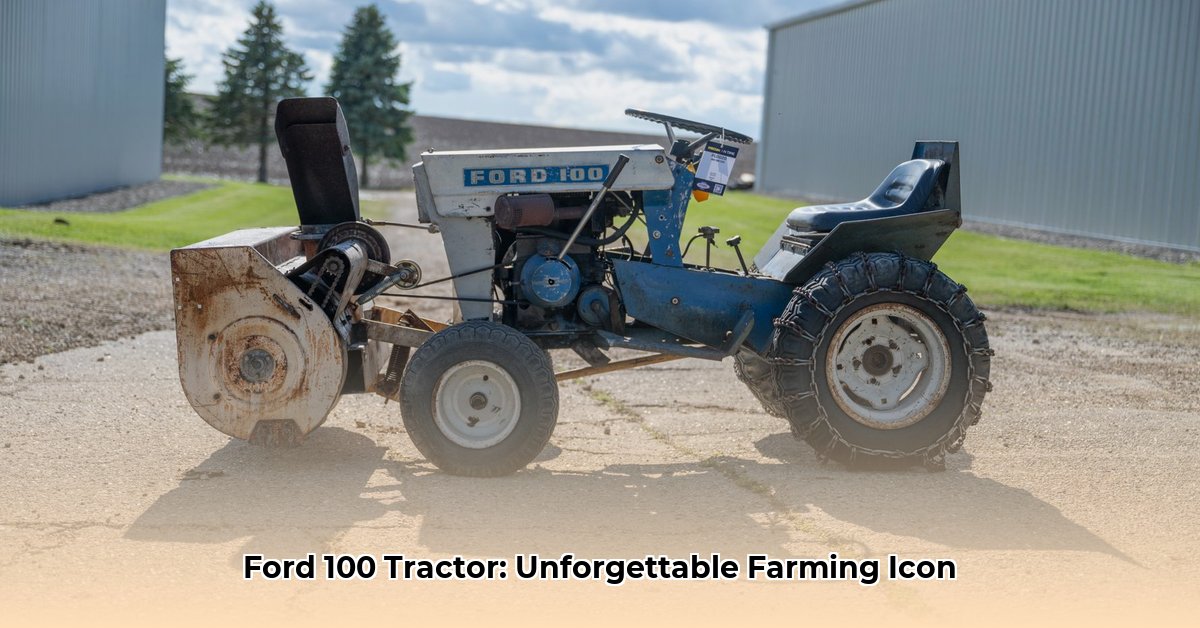
The Ford 100 tractor: a name perhaps less iconic than its larger brethren, yet a vital player in the history of American agriculture. While behemoths dominated vast fields, the Ford 100 quietly carved its niche, becoming a beloved workhorse for homeowners, smaller farms, and those seeking a practical and efficient machine. This article explores its design, historical context, and lasting legacy, revealing why this smaller tractor holds a significant place in Ford's agricultural story. For more on Ford tractor implements, see Ford 8N attachments.
Under the Hood: A Reliable Workhorse
What powered this agricultural stalwart? The Ford 100 typically featured a dependable Kohler engine, renowned for its durability and consistent performance. Its four forward gears provided the flexibility needed for diverse tasks, from tilling small gardens to mowing expansive lawns. Many models boasted a mid-mount mower deck, transforming the tractor into a versatile landscaping tool. This user-friendly design was a key factor in its widespread popularity. It wasn't just about raw power; it was about smart engineering for everyday usability. Was this practicality accidental? Absolutely not. It was a deliberate design choice reflecting Ford's understanding of the market's needs.
Did you know that the Ford 100's ease of use was a cornerstone of Ford's marketing strategy? They recognized that many farmers and landowners didn't require the immense power of larger tractors. They needed a machine that was affordable, easy to maintain, and simple to operate—a need the Ford 100 perfectly fulfilled. This focus on accessibility broadened the tractor's appeal, bringing powerful tools within reach of diverse users. This democratization of farming is a critical aspect of the Ford 100's enduring appeal.
More Than Just a Tractor: Ford's Agricultural Vision
The Ford 100 wasn't an isolated instance of innovation; it was a direct descendant of Ford's legacy in agricultural equipment. From the early Fordson tractors to the legendary 8N, Ford relentlessly pushed the boundaries of farm machinery, constantly striving for enhanced power, efficiency, and accessibility. The Ford 100 perfectly embodies this pursuit of progress. Its design reflected Ford's commitment to providing capable and affordable machinery to a wider audience. This dedication to affordability fundamentally shifted the agricultural landscape, empowering smaller farms and landowners.
A Head-to-Head Comparison: Size and Specialization
A comparison between the Ford 100 and its larger agricultural counterparts highlights its unique strengths. While lacking the raw power of larger tractors, the Ford 100 excelled in maneuverability and ease of use, ideal for smaller operations. This wasn't a deficiency, but rather a strategic advantage: a focused approach to a specific market segment. It wasn't about competing head-to-head with giants; it was about specializing in a niche, providing exactly what a certain segment of the market demanded.
| Feature | Ford 100 Tractor | Larger Agricultural Tractors (e.g., Ford 8N) |
|---|---|---|
| Engine Size | Smaller, more fuel-efficient | Larger, more powerful |
| Horsepower | Lower, ideal for smaller tasks | Higher, suitable for large-scale farming |
| Primary Use | Gardens, small farms, landscaping | Extensive field work |
| Maneuverability | Excellent, easy to handle in tight spaces | Limited, better suited to open fields |
| Cost | More affordable | Significantly more expensive |
The Ford 100's Enduring Legacy
Despite Ford's eventual exit from the tractor manufacturing business (a complex decision driven by industry consolidation and shifting market dynamics), the Ford 100's legacy remains strong. It symbolizes Ford's adaptability and enduring commitment to agricultural innovation. Its practicality and ease of use resonated with countless users, ensuring its enduring appeal among collectors, enthusiasts, and those who recall its contributions to farming history. The Ford 100 stands as more than just machinery; it's a testament to a simpler era, a symbol of hard work, reliability, and a more direct connection to the land.
How to Compare Ford Tractor Models Across Different Eras
The Ford 100's significance is amplified when viewed within the broader context of Ford tractor evolution. Comparing different Ford models across various eras requires a systematic approach, recognizing the evolution of Ford’s agricultural machinery.
Decoding the Model Numbers: A Guide to Ford Tractor History
Ford's tractor numbering systems can be complex, varying across different eras. Early Fordson models (1917-1964) often lacked a consistent numbering scheme. Later models adopted more structured alphanumeric codes offering clues about horsepower, engine size (in cubic inches), transmission type, and features like high clearance chassis or row crop configurations. Understanding these naming conventions is critical for accurate comparisons.
A Step-by-Step Comparison Guide
Let's compare the Ford 9N (1939) and the Ford 100 (late 1940s/early 1950s):
Identify Key Specifications: Begin with fundamental features: horsepower, engine displacement, weight, and transmission type. The 9N's robust design contrasts with the 100's refined features.
Examine Technological Advancements: Note improvements in hydraulic systems, fuel efficiency, and user-friendliness. These reveal advancements in engineering and design philosophy.
Analyze Performance Metrics: Compare fuel consumption, PTO power, and lifting capacity. Quantitative data illustrates the significant leaps in engineering capabilities.
Consider the Context: Analyze each model within its historical context. The 9N catered to post-Depression farmers, while the 100 aimed for enhanced productivity.
Seek Out Primary Sources: Consult original brochures, manuals, and repair guides for the most accurate information, corroborating data from various sources.
The meticulous comparison of Ford tractor models across different eras reveals not only changes in specifications but also an evolution in agricultural machine design philosophy. It's a testament to Ford's lasting impact on farming and the Ford 100's place within this rich history.